Timing & trends
 Goldman Sachs is slowly releasing their best ideas for 2014. The first two are attached below. If you have some ideas for 2014 feel free to share with the group. Here’s Goldman’s first two (via WSJ MoneyBeat):
Goldman Sachs is slowly releasing their best ideas for 2014. The first two are attached below. If you have some ideas for 2014 feel free to share with the group. Here’s Goldman’s first two (via WSJ MoneyBeat):
“Long 5-Year Eonia/Short 5-Year U.S. Treasurys.”
“The market reaction to the strengthening of ‘forward guidance’ could, contrary to our expectations, be associated with a flattening of the two-to-five year U.S. curve, at least initially.
…
“Currently, a very accommodative monetary policy stance is largely priced in in the U.S., while the market is underestimating the possibility that the European Central Bank can provide further easing, even by cutting the deposit rate below zero,”
“Long S&P 500/Short AUD”
“This reflects what is perhaps the largest overarching theme of our market outlook – a belief that developed-market equities are well placed as long as US yields do not rise too quickly. The specific implementation of this trade recommendation that we will track is a long position in Dec 2014 S&P 500 futures, and a corresponding short position in Dec 2014 AUDUSD futures. Given our forecasts for both assets, with an S&P year-end target of 1900, and a year-end AUD target vs. the USD of 0.85, we see scope for both legs of the trade to generate potential returns.”
This post originally appeared at Pragmatic Capitalism. Copyright 2013.
Read more: http://pragcap.com/goldman-sachs-2-big-ideas-for-2014#ixzz2lqeTvH2s
Risk being an inherent and precarious element of investing, hedging is basically an investment strategy employed to reduce risk by making a transaction in one market to offset a loss in another. Put more simply, hedging is taking equal and opposite positions in two negatively correlated (meaning if security A goes up, then security B goes down, and vice-versa) securities to lower risk of loss.
Theoretically, a perfect hedge would be one that eliminates all and any risk altogether from an investor’s portfolio, but that would mean there is no potential for upside either. In the real world, therefore, hedging is used by hedge funds preponderantly to reduce volatility and risk while trying to protect principal and deliver positive (absolute) returns under any and all market conditions.
 Hedge funds, actually a misnomer as not all investment strategies involve hedging, use a wide variety of alternative strategies to invest. As opposed to mutual funds, hedge funds are exempt from many rules and regulations of the SEC (and also do not have disclosure requirements). This gives hedge funds the flexibility, and advantage, of being able to invest with a wider range of strategies including hedging strategies to protect downside risk.
Hedge funds, actually a misnomer as not all investment strategies involve hedging, use a wide variety of alternative strategies to invest. As opposed to mutual funds, hedge funds are exempt from many rules and regulations of the SEC (and also do not have disclosure requirements). This gives hedge funds the flexibility, and advantage, of being able to invest with a wider range of strategies including hedging strategies to protect downside risk.
Some of the hedging techniques, each involving an array of financial implements and each offering different degrees of risk and reward, employed by hedge funds are outlined below and can be utilized by sophisticated individual investors to protect their own portfolio.
SHORT SELLING
While short selling by itself is not a hedging strategy (it is often used, though, as a hedging strategy in the context of a long-only portfolio), it is important to understand it in order to appreciate how it works as one leg of a hedging strategy.
When short selling, an investor sells borrowed shares with the anticipation that the price of the share will decline and with the intent of returning the shares back to the borrower. This is also referred to as taking a short position, as opposed to a long position (i.e. simply buying the security) which is opened in the expectation that the price of a particular stock will rise in the future.
If in actuality the price of the borrowed shares does drop, then the investor profits from buying back the borrowed shares sold and returning them to the borrower at the original price. To further clarify the profit made from a short transaction, let us consider this simple example: Assume that 100 shares are sold short by an investor for $5 a piece and her account is credited for $500. Say the price per share drops, as anticipated by the investor, to $3 and she closes out the position by buying back the 10 borrowed shares for $300. The investor makes a profit of $200, the difference between the short sale, i.e. $500, and the closing of the position, i.e. $300.
 This all might seem simple, however, an in-depth analysis has to be undertaken by an investor to arrive at the premise that the price of a particular share will in fact fall and not rise. If the price of the share does increase, the investor will end up with the short end of the stick (no pun intended) and lose money.
This all might seem simple, however, an in-depth analysis has to be undertaken by an investor to arrive at the premise that the price of a particular share will in fact fall and not rise. If the price of the share does increase, the investor will end up with the short end of the stick (no pun intended) and lose money.
Technically, the furthest the price of a share can drop to is zero and hence the upside is limited to the amount of investment, but the downside is theoretically infinite for there is no limit to what the price of a share might rise to. For this very reason the fluctuation in the price of the shares in question is followed with painstaking diligence by the investor. (Not to get ahead of ourselves, a cautious investor can hedge his short-selling risk by purchasing a call option on the same shares.)
LONG/SHORT EQUITY
Hedge funds utilize this strategy which involves buying certain stocks long and selling others short. This strategy was pioneered by Alfred W. Jones who is credited with starting the first hedge fund, A.W. Jones & Co., in 1949. Mr. Jones formulated the idea of hedging stocks by going both long and short with the aim to lessen the effects of market risk by hedging long equity positions with short positions.
To further clarify how market risk is hedged in this strategy, say that an investor might short sell a stock while buying a different one in the same industry. Now if the industry declines overall, then the short position would compensate for the loss acquired in the long position and in the case that the industry stocks rise the reverse would be true.
In either case, however, an astute balancing act has to be performed by the investor in estimating and hedging the risk to market exposure. Market exposure is determined by subtracting short positions from long positions, and the higher the difference (referred to as being ‘net long’), the higher the market risk.
ARBITRAGE
Arbitrage is the practice of simultaneously buying and selling two different, but highly correlated, stocks in the same market to profit from the unjustified disparity in their prices. Conversely, arbitration can be achieved by buying and selling the same stock in different markets and taking advantage of pricing inefficiencies (these opportunities are less and less common in today’s world of electronic trading). Ideally, an arbitrage transaction involves very little (if any) cash outflow and hence has the possibility of a very low-risk profit with very low cost to boot.
Arbitrage, sometimes referred to as ‘risk arbitrage’ or ‘merger arbitrage’, can be applied to special situations where a business is being acquired by, or merging with, another business. When a publicly traded business is being acquired, the acquiring business makes a tender offer – to the shareholders of the business being procured – which is usually higher than the market price. An investor may profit from this situation by buying the shares (at a lower price than the tender offer) of the company being acquired immediately after the tender offer has been announced, and then turning around to sell the shares back to the acquiring company at the tender price.
Practically speaking, the risk involved in jumping into the fray of special situations relies upon two main factors: Will the merger or acquisition go through? And, if it does go through, what will be the amount of the final tender offer? These two risks can be taken head-on and be classified as pre-emptive and post-tender respectively. The former being more risky as it is speculative and visceral because the investor purchases shares based upon the conjecture that the M&A deal will materialize. And assuming that the merger does go through, the final tender price may come in higher or lower than the original tender. (Again, not to get ahead of ourselves, these risks can be mitigated by being long convertible bonds and short the underlying equity.)
OPTIONS
An option, akin to a future, is essentially a derivative. A derivative is anything whose value is based upon some other asset, i.e. it derives its value from something else. Specifically, derivatives are securities whose prices are based on the prices of an underlying asset, namely equities, bonds, real estate, commodities, etc. Derivatives are prominently used to hedge and reduce risk of an investment in the underlying security. Besides futures, the most common derivatives used for hedging are options which are used to develop a hedging strategy where a loss in an investment can be offset by a gain in the option contract.
 There are myriad ways of using options to hedge a portfolio. One common use of options is to curtail the possibility of losses in a specific security. An investment can be protected by buying a put option on it — this gives the investor the right to sell the investment at a specified price (known as the strike price) for a specified time period. Now, if the stock price falls below the strike price, then the losses can be compensated for by gains in the put option (meaning one does not have to exercise the put option). In the same fashion, a call option can be used to hedge losses arising from a short position in a stock, as the call option gives the investor the right to buy the stock at a specified price.
There are myriad ways of using options to hedge a portfolio. One common use of options is to curtail the possibility of losses in a specific security. An investment can be protected by buying a put option on it — this gives the investor the right to sell the investment at a specified price (known as the strike price) for a specified time period. Now, if the stock price falls below the strike price, then the losses can be compensated for by gains in the put option (meaning one does not have to exercise the put option). In the same fashion, a call option can be used to hedge losses arising from a short position in a stock, as the call option gives the investor the right to buy the stock at a specified price.
(Reuters) – When Aimee Brittain’s team hits the stores in a commando-like fashion on Thanksgiving night in search of Black Friday deals, they’ll stand out from the crowd in their matching “very bright blue” shirts. They’ll scatter when they hit the store, and the shirts will help them see each other quickly.
It’s different for the Goldman sisters. Stephanie Goldman, a Cliffside Park, New Jersey, public relations executive, and her sisters Nadine Kleinman of Highland Park, New Jersey, and Valerie Goldman of Washington, D.C., travel in a pack, flooding one zone at a time.
The strategy, honed when Stephanie was a young teen, has helped them score priority bargains, like the time they got $900 worth of clothes from Ann Taylor for about $100. They went that Black Friday to an outlet store, already full of discounted items, hit the clearance rack, where prices were further reduced, then tacked on the credit-card application discount.
This year, Black Friday starts earlier than ever, with some retailers, including Wal-Mart, opening early on Thanksgiving evening. About 140 million people were expected to shop over the four-day weekend, according to the National Retail Federation.
Goldman, Brittain and other warriors who will prowl for deals on the busiest of shopping days took time from their mission planning to share war stories and tips to those who want to spend less and get more on the day after Thanksgiving. Here are their tips and tales:
SET YOUR STRATEGY
A Black Friday neophyte will shop without a plan. The veteran shopper knows where to go and when, what to buy, and how much to pay.
Goldman and her sisters start months ahead. Over calls and emails, they analyze sales flyers and figure out where the best deals are on the items they want to buy. Many flyers have been available for weeks – Macy’s and Toys R Us for example – collected on sites such as BlackFriday.com.
Brittain, 35, who lives near Atlanta, starts later, but plans to a more extreme degree. A week before Thanksgiving, she and her pack – family and friends including her cousin, her grandmother and an aunt – will pore over the circulars and craft plans right down to the amount of space available in their cars to cart away their booty.
USE THE BUDDY SYSTEM
Brittain’s crew take teamwork seriously. They hit a specific store and go to multiple departments at once, keeping each other on speed-dial to discuss items they have spotted or if someone needs a helping hand. “We call it divide and conquer. It’s battle. It’s war,” she says.
The strategy has paid off handsomely, says Brittain, who writes the prettyfrugaldiva.com blog. “All my kitchen supplies have been purchased at Black Friday sales, and I haven’t paid more than $5 for them.”
That includes a blender, mixer, coffee maker and electric can opener.
The Goldman clan travels as a pack, Stephanie says, allowing honest assessments about clothing choices and whether the price is really a bargain. Once they’re on the move, they will shop for eight to 14 hours.
Even if you can’t field a team, shop with a wingman. Christina Wojciechowski, 37, of Orchard Park, New York, goes with one partner, either her brother or sister-in-law. When she heads out late Thanksgiving night, it is not only comforting to have someone you know with you, she says, but you can help each other find what you’re looking for.
THE FIRST (PRICE) CUT IS THE DEEPEST
Lining up typically starts on Thanksgiving night, when the first wave of stores get ready to open. This presents the toughest decision: Where do you start?
That first location has to be worth the investment of time, but not at the expense of other deals. Wojciechowski heads out about 10 p.m. and usually goes to a store that sells clothing.
The lines at the electronics stores, where they sell a handful of deeply discounted items like a $1,000 55-inch flat-screen TV for $500 and a $400 laptop for $178, are likely to be considerably longer. And at the electronics store, the front of the line probably sacrificed Thanksgiving dinner to get there – Best Buy will open at 6 pm on the holiday this year.
Even the best deal isn’t worth the stress of spending hours waiting in line for a store to open, says Wojciechowski. Instead she pops into drugstores like CVS and Rite Aid on Black Friday because they typically offer deals on small electronics and toys and usually aren’t crowded.
PACK SUPPLIES
Being on email lists, Facebook fan pages for retailers and checking on deal sites will offer clues on added bonuses and could provide access to special coupons or unadvertised deals.
Bring your lists, loyalty cards, and coupons. Load up your smartphone with coupon-offering apps like CouponSherpa or RetailMeNot, or apps for stores where you will shop. You’ll be able to check for last-minute deals while you’re in the field.
And don’t forget fuel. David Bakke, an editor at the personal finance site MoneyCrashers.com, brings juice and energy bars to avoid stopping as he goes from store to store.
FAILURE IS NOT AN OPTION
Going for a big-ticket item involves risk, since the competition is intense. But Jen Smialek, 32, a Boston-based freelance writer and web designer, has learned many stores have consolation prizes. The deals might not be as good, she says, but could be nearly the same.
Smialek says the key is talking to a store employee about the “extra” inventory that will be wheeled out during the day to take the place of the cleaned-out doorbuster deals. Or talk a manager into giving you a sale price on a similar item.
You have nothing to lose by asking, and Smialek says it has been a winning proposition for her. She recalls going after a TV deal with a nearly $1,000 markdown.
“I was able to get her to reduce the price of the TV I had, to match the doorbuster sale. No fuss, no muss, in and out of the store in 30 minutes with what I came for at the price I wanted.”
(This version of the story corrects Aimee Brittain’s age in paragraph eight to 35 from 45.)
(Follow us @ReutersMoney or here Editing by Linda Stern and Jeffrey Benkoe

(L-R) Germany’s Foreign Minister Guido Westerwelle, British Foreign Secretary William Hague, Chinese Foreign Minister Wang Yi, U.S. Secretary of State John Kerry, French Foreign Minister Laurent Fabius, Russia’s Foreign Minister Sergei Lavrov, EU foreign policy chief Catherine Ashton and Iranian Foreign Minister Mohammad Javad Zarif gather at the United Nations Palais in Geneva November 24, 2013.
Saturday night had turned into Sunday morning and four days of talks over Iran’s nuclear program had already gone so far over schedule that the Geneva Intercontinental Hotel had been given over to another event.
A black tie charity ball was finishing up and singers with an after party band at a bar above the lobby were crooning out the words to a Johnny Cash song – “I fell into a burning ring of fire” – while weary diplomats in nearby conference rooms were trying to polish off the last touches of an accord. Negotiators emerged complaining that the hotel lobby smelled like beer.
At around 2:00 a.m., U.S. Secretary of State John Kerry and counterparts from Britain,China, France, Germany and Russia were brought to a conference room to approve a final text of the agreement which would provide limited relief of sanctions on Iran in return for curbs to its nuclear program.
At the last minute, with the ministers already gathered in the room, an Iranian official called seeking changes. Negotiators for the global powers refused. Finally the ministers were given the all clear. The deal, a decade in the making, would be done at last.
Now that the interim deal is signed, talks are far from over as the parties work towards a final accord that would lay to rest all doubts about Iran’s nuclear program.
“Now the really hard part begins,” Kerry told reporters. “We know this.”
….read more HERE in this Special Report
The Bottom Line
Economic sensitive sectors with strong positive seasonality traits (e.g. Industrials, Consumer Discretionary, Technology and Materials) are leading equity markets on the upside. Preferred strategy is to accumulate equity markets and sectors with favourable seasonality on weakness in order to take advantage of the October 28th to May 5th period of strength.
Equity Trends
The S&P 500 Index added 6.58 points (0.37%) last week. Trend remains up. The Index closed at an all-time high. The Index remains above its 20, 50 and 200 day moving averages. Short term momentum indicators remain at overbought levels.

Percent of S&P 500 stocks trading above their 50 day moving average slipped last week to 78.20% from 82.80%. Percent remains overbought.
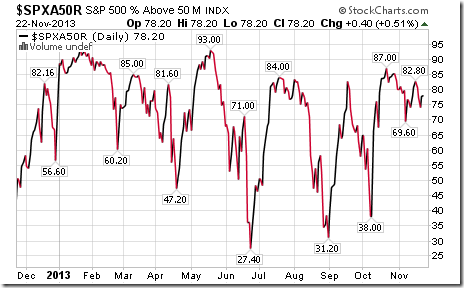
Percent of S&P 500 stocks trading above their 200 day moving average slipped last week to 84.40% from 85.60%. Percent remains intermediate overbought.
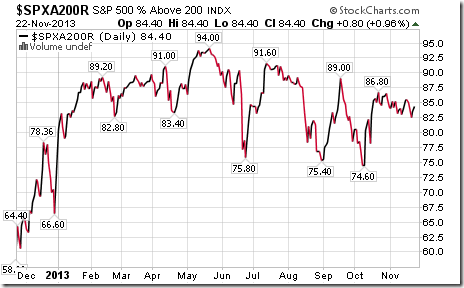
Bullish Percent Index for S&P 500 stocks increased last week to 83.80% from 83.40% and remained above its 15 day moving average. The Index remains intermediate overbought.
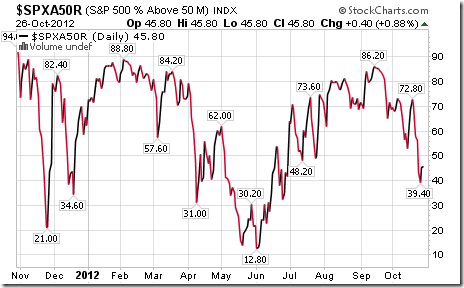
The TSX Composite Index slipped 4.23 points (0.03%) last week. Trend remains up (Score: 1.0). The Index remains above its 20 day moving average (Score: 1.0). Strength relative to the S&P 500 Index remains negative (Score: 0.0). Total score based on the above technical indicators remains at 2.0 out of 3.0. Short term momentum indicators remain overbought.
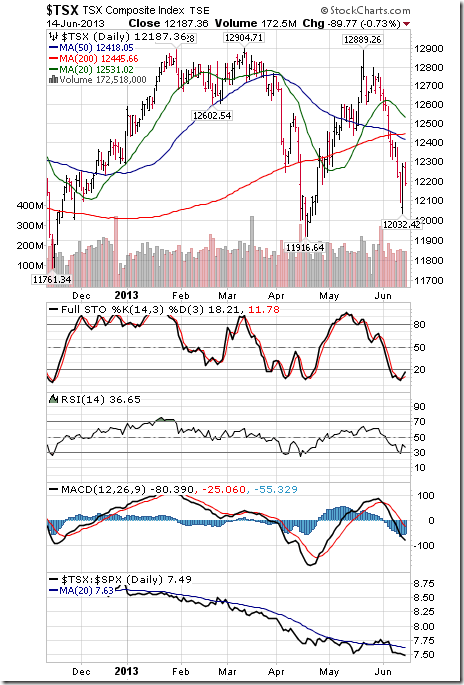
Percent of TSX Composite stocks trading above their 50 day moving average slipped last week to 58.58% from 62.76%. Percent remains intermediate overbought with a downward bias.
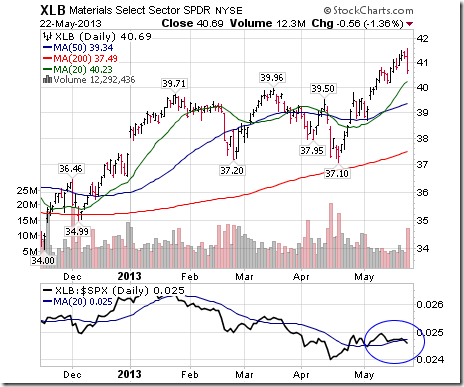
Percent of TSX Composite stocks trading above their 200 day moving average slipped last week to 56.90% from 57.74%.Percent remains intermediate overbought with a downtrend.
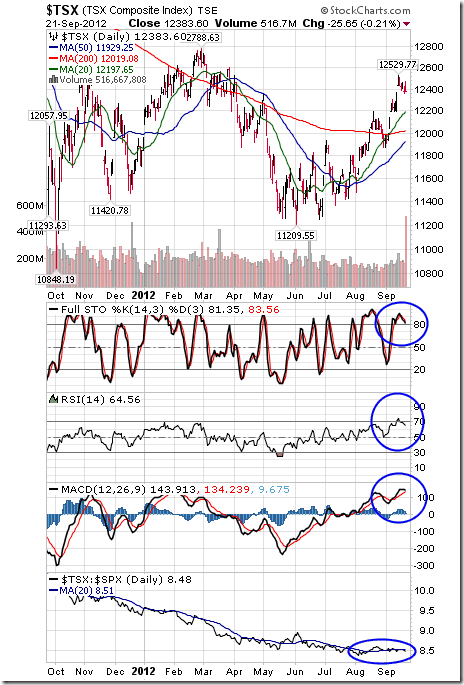
….read and so much more as 34 more charts & other issues are studied in this detail HERE













